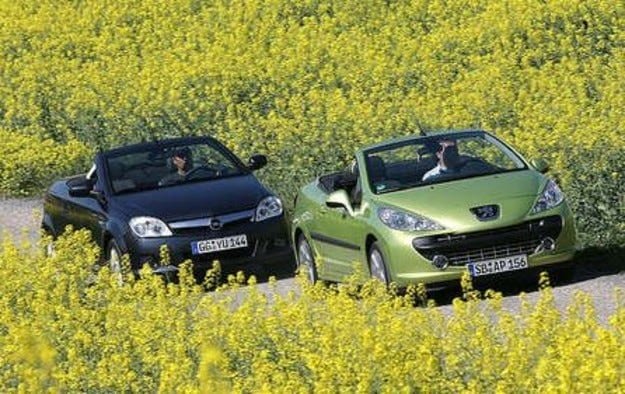
Test drive Opel Tigra vs Peugeot 207 CC: ready for summer
Content

Both cars use power folding metal roofs that convert them from coupe to convertible or vice versa in seconds. Can the Peugeot 207 CC beat its rival from Rüsselsheim, the Opel Tigra Twin Top?
The small-class revolutionary Peugeot 206 CC has become an absolute hit on the market, offering the feeling of a convertible at a very reasonable price. Peugeot has clearly plucked up courage as the 207 CC is positioned higher, including on price. But not only that - the car is 20 centimeters longer, which makes its appearance more mature, but did not affect either the position of the rear seats or the capacity of the luggage compartment. The truth is that for reasons that are completely incomprehensible, the trunk has even been slightly reduced compared to its predecessor, and the rear seats actually serve only as a place for additional luggage.
Opel has completely retained the rear seats in the Tigra Twin Top, which, when the roof is raised, help the car look almost like a full-fledged coupe. Behind the two seats is a luggage compartment with a volume of 70 liters. The trunk is especially impressive when the guru is up – then its capacity is 440 liters, and when the roof is lowered, its volume decreases to a still quite decent 250 liters. At the Peugeot, removing the roof limits the cargo space to a modest 145 liters. Tigra owners must come to terms with the fact that when the roof is lowered, the tailgate opens only with a long press of a button - an obvious misconception on the part of the Corsa derivative made by Heuliez. This does not mean that the French opponent performs very well in this regard - the procedure is no less illogical with him.
You feel good in front of both cars
The cabin of the German challenger is borrowed directly from the Corsa C, which has both advantages and disadvantages. The good thing in this case is that the ergonomics are traditionally good, but the bad thing is that the interior of a small convertible looks one idea simpler than it needs to be. The predominant material is hard plastic, and the position behind the height-adjustable steering wheel can hardly be called sporty. The 207 SS sport seats provide nice lateral support and the driving position is solid, aside from the danger of tall riders leaning their heads against the reclined windshield (in fact, both models have this feature).
The 207 boasts a significant improvement over the 206 in terms of driving feel with the roof down. The wide front speakers significantly limit the view, especially in the case of Opel.
On bad roads, both cars don't work brilliantly.
The Opel is 170 kilograms lighter than the 207 and, with its already nimble engine, delivers excellent dynamic performance. The pronounced tendency to understeer is easily overcome by careful handling of the accelerator pedal, without oversteer and the electronic stabilization system rarely has to work. The behavior of the 207 CC on the road is similar - the car is quite stable in corners, even showing some sporting ambitions. However, in everyday use, the Tigra is especially annoying with its rough handling of bumps, and on harder impacts, body noise begins to be heard - a problem that is also inherent in the Peugeot 207 CC.
Text: Jorn Thomas
Photo: Hans-Dieter Zeifert
Evaluation
1.Peugeot 207 CC 120 Sport
The 207 SS is a worthy successor to its predecessor with ample front seat space and safe and reasonably comfortable handling. The 1,6-liter engine could be more agile, and the build quality has some drawbacks.
2.Opel Tigra 1.8 Twintop Edition
The Opel Tigra is a sportier alternative to the 207 CC, but comfort is limited and the driving position isn't the best in the segment. Despite the fact that Opel was equipped with a more powerful engine, in this test, Opel lost to its French rival.
technical details
| 1.Peugeot 207 CC 120 Sport | 2.Opel Tigra 1.8 Twintop Edition | |
|---|---|---|
| Working volume | - | - |
| Power | 88 kW (120 hp) | 92 kW (125 hp) |
| Maximum torque | - | - |
| Acceleration 0-100 km / h | 11,9 with | 10,3 with |
| Braking distances at a speed of 100 km / h | 38 m | 39 m |
| full speed | 200 km / h | 204 km / h |
| Average consumption fuel in the test | 8,6 l / 100 km | 8,8 l / 100 km |
| Base Price | 40 038 levov | 37 748 levov |